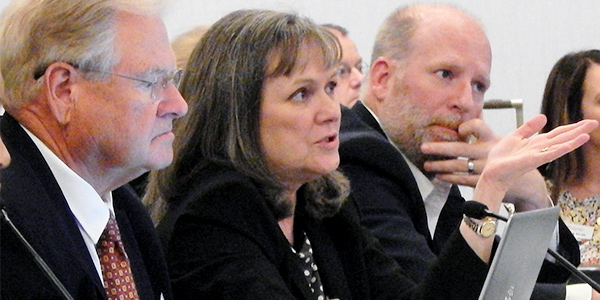MISO’s and SPP’s market monitors on Monday presented their last report to state regulators working to improve the RTOs’ interregional coordination, but members seemed more interested in the lack of joint projects between the two.
MISO Independent Market Monitor David Patton presented his report on interface pricing to the Seams Liaison Committee (SLC), composed of regulators from the Organization of MISO States (OMS) and SPP’s Regional State Committee (RSC). It was the last of the monitors’ studies and reports commissioned by the SLC.
When invited to give their chief concerns about the grid operators’ coordination, stakeholders seemed less focused on interface pricing and more interested in why the RTOs have been unable to agree on beneficial interregional transmission projects.
The American Wind Energy Association’s Daniel Hall criticized the RTOs’ use of different planning futures, models and assumptions in their coordinated system plan (CSP), the studies they use to search for interregional projects.
“There is a need for large interregional projects, but it’s not showing up in the regional studies, and that’s a problem and we need to address that,” he said.
MISO last week said it doesn’t plan to endorse any interregional project possibilities this year after a fourth CSP with SPP. (See MISO, SPP Close to Ruling out Joint Projects Again.)
ITC Holdings’ Brenda Prokop said many transmission owners are similarly questioning the design of the RTOs’ interregional planning, especially since because the TOs are forecasting a “strong need” for transmission buildout along the seam.
“We’re wondering if it’s the most cost-effective and efficient way for the RTOs to be planning in their separate regional process,” Prokop said. She also asked that MISO and SPP “line up” their models and assumptions.
Hall suggested the regulators consider urging the RTOs to create a new category for small, economic interregional transmission projects, called targeted market efficiency projects. MISO and PJM debuted the project type three years ago and have since approved two portfolios of smaller projects.
American Electric Power’s Jim Jacoby said regulators should support the creation of the project type. MISO and SPP considered developing smaller projects two years ago but called off the effort. (See MISO, SPP Mulling Small Interregional Project Type.)
Hall also urged regulators to investigate the eradication of rate pancaking and the possibility of a joint dispatch model between the two RTOs. He said the monitors’ earlier conclusion that joint dispatch wouldn’t benefit the grid operators doesn’t consider reliability advantages and the possibility of capacity-sharing.
Members: Tx, Please
The IMM’s study on interface pricing concluded that the RTOs need only include congestion from their monitored constraints when calculating interface prices. Currently, both MISO and SPP estimate the flow’s impact and congestion costs on all market-to-market (M2M) constraints, even those they aren’t monitoring.
“Both of us are pretty much estimating the full impact of scheduling the transaction,” Patton said. “In the report, we call this a redundant payment, and it is the primary problem identified in the report that needs to be solved.”
Patton said interface payments can be large because the RTOs’ congestion-calculating redundancies exaggerate the cost of moving power over constraints.
He also said nothing in the RTOs’ joint operating agreement provides for refunds when interface prices are overinflated by twice-counted congestion on M2M constraints.
“So ultimately, those payments are just going to show up as uplift that SPP customers pay on MISO constraints, and vice versa,” Patton said.
Texas Public Utility Commission Chair DeAnn Walker asked why the RTOs aren’t already calculating congestion on just their monitored M2M constraints.
“The RTOs aren’t doing this yet because it hasn’t risen to the top of the heap,” Patton said. He said the switch would entail software changes for both grid operators. That might be especially difficult for MISO, as its IT crews are already taxed with rolling out a new market platform.
The OMS and RSC have discussed presenting by year-end a list of recommendations on how the RTOs can better coordinate across the seam. (See MISO, SPP Regulators Mull Seams Recommendations.)
Walker said that as the regulators compile their list of recommended improvements, they might reach out to the monitors for advice.
“I don’t think they’re totally off the hook,” she said. “In forming our recommendations, we may ask for some input.”
“As market monitors, we see evidence of things not working well. I think state involvement is very important,” Patton said.
Hall said regulators should keep the SLC alive after it issues recommendations to oversee the RTOs’ handling of them and to continue monitoring areas of improvement in seams coordination.
The SLC will meet again Sept. 14. RTO staffs are expected to appear and respond to the monitors’ and members’ ideas for improvement.



